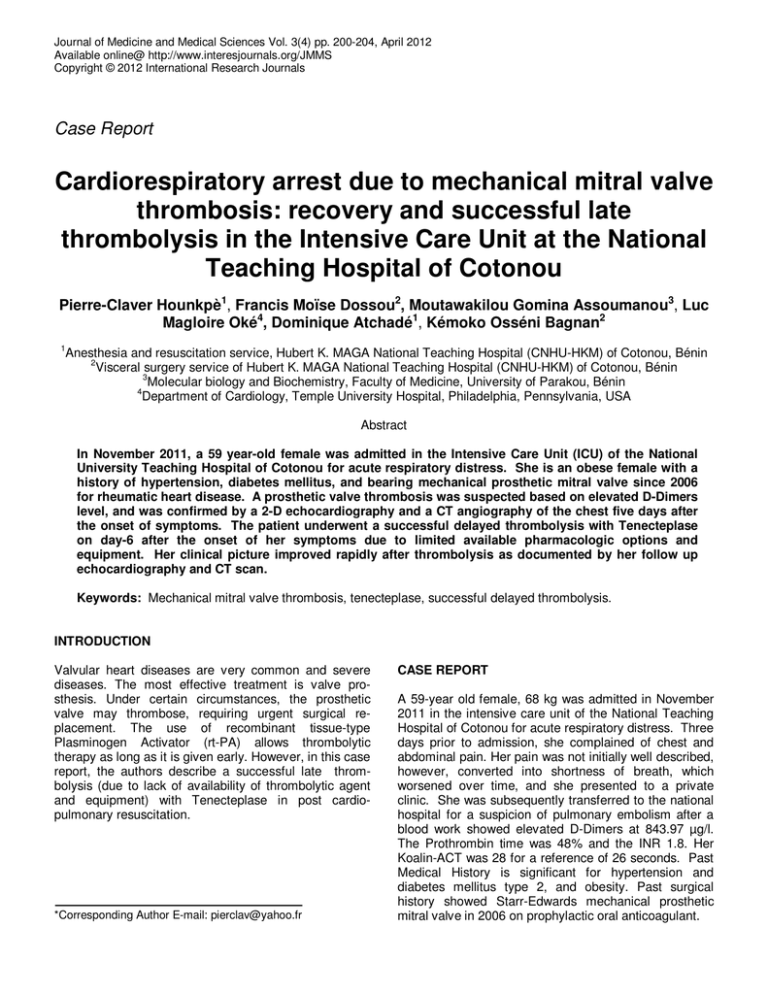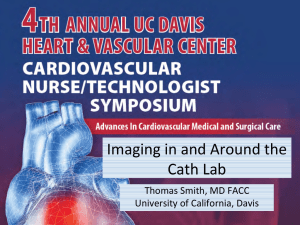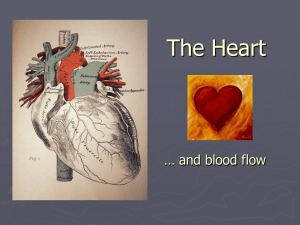Document 14239995
advertisement

Journal of Medicine and Medical Sciences Vol. 3(4) pp. 200-204, April 2012 Available online@ http://www.interesjournals.org/JMMS Copyright © 2012 International Research Journals Case Report Cardiorespiratory arrest due to mechanical mitral valve thrombosis: recovery and successful late thrombolysis in the Intensive Care Unit at the National Teaching Hospital of Cotonou Pierre-Claver Hounkpè1, Francis Moïse Dossou2, Moutawakilou Gomina Assoumanou3, Luc Magloire Oké4, Dominique Atchadé1, Kémoko Osséni Bagnan2 1 Anesthesia and resuscitation service, Hubert K. MAGA National Teaching Hospital (CNHU-HKM) of Cotonou, Bénin 2 Visceral surgery service of Hubert K. MAGA National Teaching Hospital (CNHU-HKM) of Cotonou, Bénin 3 Molecular biology and Biochemistry, Faculty of Medicine, University of Parakou, Bénin 4 Department of Cardiology, Temple University Hospital, Philadelphia, Pennsylvania, USA Abstract In November 2011, a 59 year-old female was admitted in the Intensive Care Unit (ICU) of the National University Teaching Hospital of Cotonou for acute respiratory distress. She is an obese female with a history of hypertension, diabetes mellitus, and bearing mechanical prosthetic mitral valve since 2006 for rheumatic heart disease. A prosthetic valve thrombosis was suspected based on elevated D-Dimers level, and was confirmed by a 2-D echocardiography and a CT angiography of the chest five days after the onset of symptoms. The patient underwent a successful delayed thrombolysis with Tenecteplase on day-6 after the onset of her symptoms due to limited available pharmacologic options and equipment. Her clinical picture improved rapidly after thrombolysis as documented by her follow up echocardiography and CT scan. Keywords: Mechanical mitral valve thrombosis, tenecteplase, successful delayed thrombolysis. INTRODUCTION Valvular heart diseases are very common and severe diseases. The most effective treatment is valve prosthesis. Under certain circumstances, the prosthetic valve may thrombose, requiring urgent surgical replacement. The use of recombinant tissue-type Plasminogen Activator (rt-PA) allows thrombolytic therapy as long as it is given early. However, in this case report, the authors describe a successful late thrombolysis (due to lack of availability of thrombolytic agent and equipment) with Tenecteplase in post cardiopulmonary resuscitation. *Corresponding Author E-mail: pierclav@yahoo.fr CASE REPORT A 59-year old female, 68 kg was admitted in November 2011 in the intensive care unit of the National Teaching Hospital of Cotonou for acute respiratory distress. Three days prior to admission, she complained of chest and abdominal pain. Her pain was not initially well described, however, converted into shortness of breath, which worsened over time, and she presented to a private clinic. She was subsequently transferred to the national hospital for a suspicion of pulmonary embolism after a blood work showed elevated D-Dimers at 843.97 µg/l. The Prothrombin time was 48% and the INR 1.8. Her Koalin-ACT was 28 for a reference of 26 seconds. Past Medical History is significant for hypertension and diabetes mellitus type 2, and obesity. Past surgical history showed Starr-Edwards mechanical prosthetic mitral valve in 2006 on prophylactic oral anticoagulant. Hounkpè et al. 201 Figure 1. Echocardiography prior to valve thrombolysis Of note, she recently returned few days ago from a long trip to Asia. On physical examination, she is a middle age female appearing ill, oral mucosa is normal, she is mildly overhydrated and is in respiratory distress with a respiratory rate of 40/minute, blood pressure of 180/110 mmHg and pulse of 110 bpm. Her oxygen saturation was 40 % on room air. On lung auscultation, she had decreased breath sounds and bilateral rales. On cardiac auscultation, no prosthetic valve sound is noted, her rhythm is irregular and rapid. During physical examination, she developed a cardio-respiratory arrest, which required resuscitation and mechanical ventilation. Heparin infusion was rapidly started. Her hemoglobin level was 12g/dl. Measurement of blood gas tensions and pH was not available. ECG showed atrial fibrillation with rapid ventricular response, there was a prominent S in lead 1 and Q in lead 3. The 2-D echocardiography and the CT angiography of the chest were not immediately available. She immediately regained consciousness despite the persistence of respiratory distress. Her oxygen saturation continued to worsen and she failed weaning trial on several occasions. On day -5, she was transported for an outpatient 2-D echocardiography and CT angiography of the chest. The echocardiography disclosed a mobile mass attached to the mitral prosthetic valve. There was a significant right-sided dilatation and a moderate pulmonary hypertension with RV systolic pressure of 51.2 mmHg (Figure 1). The CT angiography of the chest did not show major pulmonary embolism, however, it disclosed alveolar infiltrates and bilateral pleural effusion (see Figure 3). Fibrinolytic agents were not readily available. On December 1rst, we were able to acquire Tenecteplase (6 days after the onset of her symptoms). She received the fibrinolytic agent according to her weight, the recommended dosage of 40 mg. Heparin was discontinued during fibrinolysis and resumed afterwards. No hemorrhage was noted; she was successfully weaned off mechanical ventilation 12 hours later and extubated on December 2nd 2011. A follow up echocardiography (figure 2) and CT angiography of the chest (figure 4) showed a mechanical ball-in-cage prosthetic mitral valve with good mobility. Significant reductions in size of the thrombus size as well as decreased pulmonary pressures are noted. On CT angiography of the chest, pleural effusions persisted, however alveolar infiltrated were significantly reduced. The patient was discharged from the hospital to home on December 8th following a short physical therapy. 202 J. Med. Med. Sci. Figure 2. Echocardiography after valve thrombolysis Figure 3. Chest CT prior to valve thrombolysis Hounkpè et al. 203 Figure 4. Chest CT after valve thrombolysis DISCUSSION One may wonder the pathophysiology of prosthetic valve thrombosis in a patient on chronic anticoagulant treatment with Acenocoumarol. One may surmise after ruling out the role of sub therapeutic drug level, noncompliance, which may result in high risk of valve thrombosis. The result of the coagulation panel appears to support that hypothesis. The mildly elevated level of the D-Dimers, considering the patient age suggests increased thrombotic risk. According to Parent (2007), obtaining D-Dimers level is integral part of the diagnostic algorithm in thromboembolic diseases. Her previous long flight could be considered as a risk factor for thromboembolic events although there is no clear association between long air flight and thromboembolic disease (Sanchez and Meyer, 2007). The major delay in the diagnosis is due to our limited equipment and means resulting to a dysfunctioning health care system. These limitations explain the inability to give priority to bedside diagnostic tests such as echocardiography as suggested by Meyer and Sanchez (2008). With respect to the management of thromboembolic diseases, even though the introduction of fibrinolytic agents was a turning point, the use of new thrombolytic agents such as rtPA was a major step forward. Slaoui et al. (2010) successfully treated a 34-year-old pregnant female for a thrombosed Starr-Edwards mechanical valve. Viedt et al (1999) successfully treated a 48-year-old female who received a mitral mechanical prosthetic valve 3 years earlier. However, despite the progress noted, our limited means and the delay in performing the non invasive imaging studies such as echocardiography and CT angiography of the chest plus an additional 24 hours delay before thrombolytic treatment was administered, resulted in a total of 6 –day delay from the onset of the symptoms. In the absence of contraindication, thrombolysis was the only treatment option available in our hospital where surgical option is not an alternative. In retrospect, it was in the best interest of this patient to avoid surgery. According to Bastien et al (2009), advanced age results in complicated and protracted postoperative period. Nouette et al (2005) noted that there was no consensus with respect to the use of anticoagulant in postoperative management of prosthetic valve replacement. Knowing the extent of short and long-term complications related to Starr-Edwards prosthetic valves, such as thromboembolic events, hemorrhages, and infections 204 J. Med. Med. Sci. (Zouaoui et al., 2009), one should consider valve replacement as long-term solution in our patient. Bastien et al (2009) noted a high frequency of mechanical prosthetic valves thrombosis compared to bioprosthetic valves, especially those in mitral position. Nowadays, the use of rt-PA is made easy by the simplicity of the protocol, which consists of a single bolus injection, well tolerated and with relative safety; especially Tenecteplase, which was used in pregnancy (Boursier et al., 2004; Slaoui et al., 2010). The successful outcome of this case should result in increased availability of thrombolytic agents in our hospital. One should, however realize that occasional incomplete thrombolysis can occur, and surgical alternative should be available (Fadel et al., 2008). The early use of unfractionated heparin during the course of her treatment was beneficial. While waiting for the thrombolytic agent, the use of heparin infusion decreased the thrombus formation (Gut-Gobert et al., 2008). The rapid clinical improvement few hours after administration of the Tenecteplase which allowed a quick weaning off mechanical ventilator is in agreement with Meyer’s observations (2007), who noted a 30 % decrease in pulmonary artery obstruction two hours following thrombolytic treatment in a case of pulmonary embolism. CONCLUSION Early use of rt-PA results in rapid thrombolysis. However, in the absence of surgical alternative in our setting, we successfully performed a delayed thrombolysis six days after the onset of symptoms in a patient with thrombosed mechanical prosthetic mitral valve. REFERENCES Bastien O, Flamens C, Cannesson M (2009). Problèmes postopératoires graves en chirurgie cardiaque. In : Boles J-M, Bollaert P-E, Jaeger A, Offenstadt G, Saulnier F, Wolff M, Zéni F, Collège National des Enseignants de Réanimation Médicale : Réanimation médicale, Elsevier Masson SAS, 839-842. Boursier F, Maistre J P, Saddedine M, Pernot T, Adnet F (2004). Thrombolyse préhospitalière d’une embolie pulmonaire avec état de choc sévère. Annales françaises d’anesthésie et de réanimation. 23: 1182-1184. Fadel E, Jais X, Mercier O, Mussot S, Angel C, Paul JF, Humbert M, Simonneau G, Dartevelle P (2008). Embolie pulmonaire chronique. EMC (Elsevier Masson SAS), Techniques chirurgicales-Thorax, 42492 Gut-Gobert C, Couturaud F, Leroyer C, Sanchez O (2008). Prise en charge de l’embolie pulmonaire à la phase aiguë. Revue de pneumologie clinique. 64 (6): 298-304. Meyer G (2007). Thrombolyse dans l’embolie pulmonaire. Le praticien en anesthésie réanimation. 11 (3): 171-175. Meyer G, Sanchez O (2008). Embolies pulmonaires graves: diagnostic et prise en charge. EMC (ELSEVIER Masson SAS), Pneumologie, 6-024-B-22 Nouette K, Richebé P, Calderon J, Mouton C, Janvie G (2005). Gestion en période périopératoire de l’anticoagulation des valves prothétiques cardiaques. Annales françaises d’anesthésie et de réanimation. 24 (6): 621-631. Parent (2007). Démarches diagnostique et thérapeutique devant une suspicion d’embolie pulmonaire. EMC (Elsevier Masson SAS), AKOS (Traité de Médecine), 6-0635 Sanchez O, Meyer G (2007). Voyages aériens et maladies thromboemboliques veineuses. EMC (Elsevier Masson SAS), Pneumologie, 6-024-B-23 Slaoui M, Cherradi R, Ounzar M, Massou S, Srairi J E (2010). Thrombose d’une prothèse valvulaire de Starr traitée avec succès par ténectéplase au cours d’une grossesse. Annales françaises d’anesthésie et de réanimation. 2 (6): 500-501. Viedt C, Mereles D, Kübler W, Kreuzer J (1999). Thrombosis of a mitral valve prosthesis successfully treated with fibrinolysis. Clin. Res. Cardiol. 89 (8): 698-701. Zouaoui W, Ouldzein H, Drissa M A, Essafi N, Meddeb I, Drissa H (2009). Résultats à court et long terme du remplacement valvulaire mitral par prothèse mécanique à bille et à ailettes (à propos d’une série de 236 patients consécutifs avec un suivi moyen de 11 ans). Annales de cardiologie et d’angéiologie. 58 (2): 86-93.


